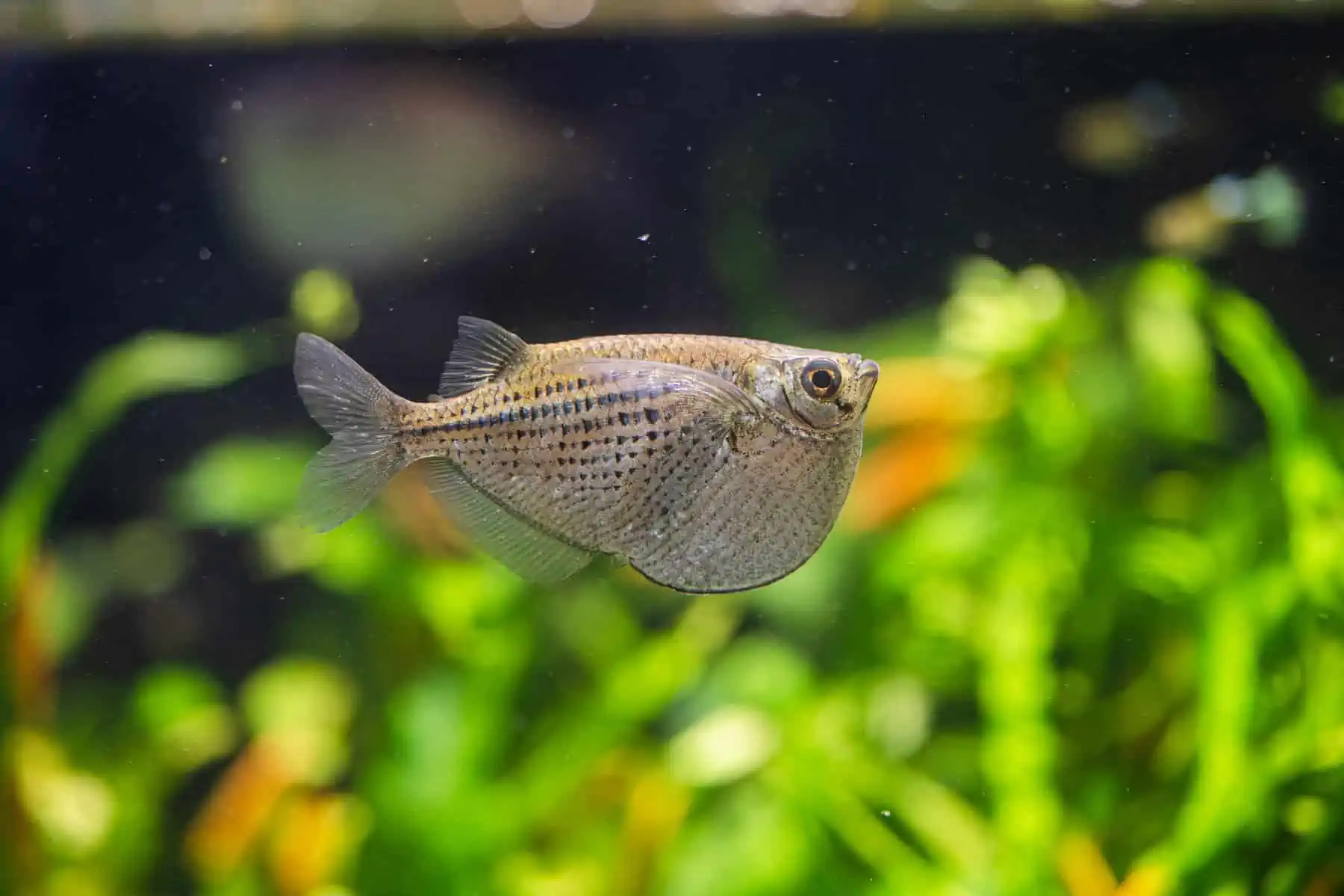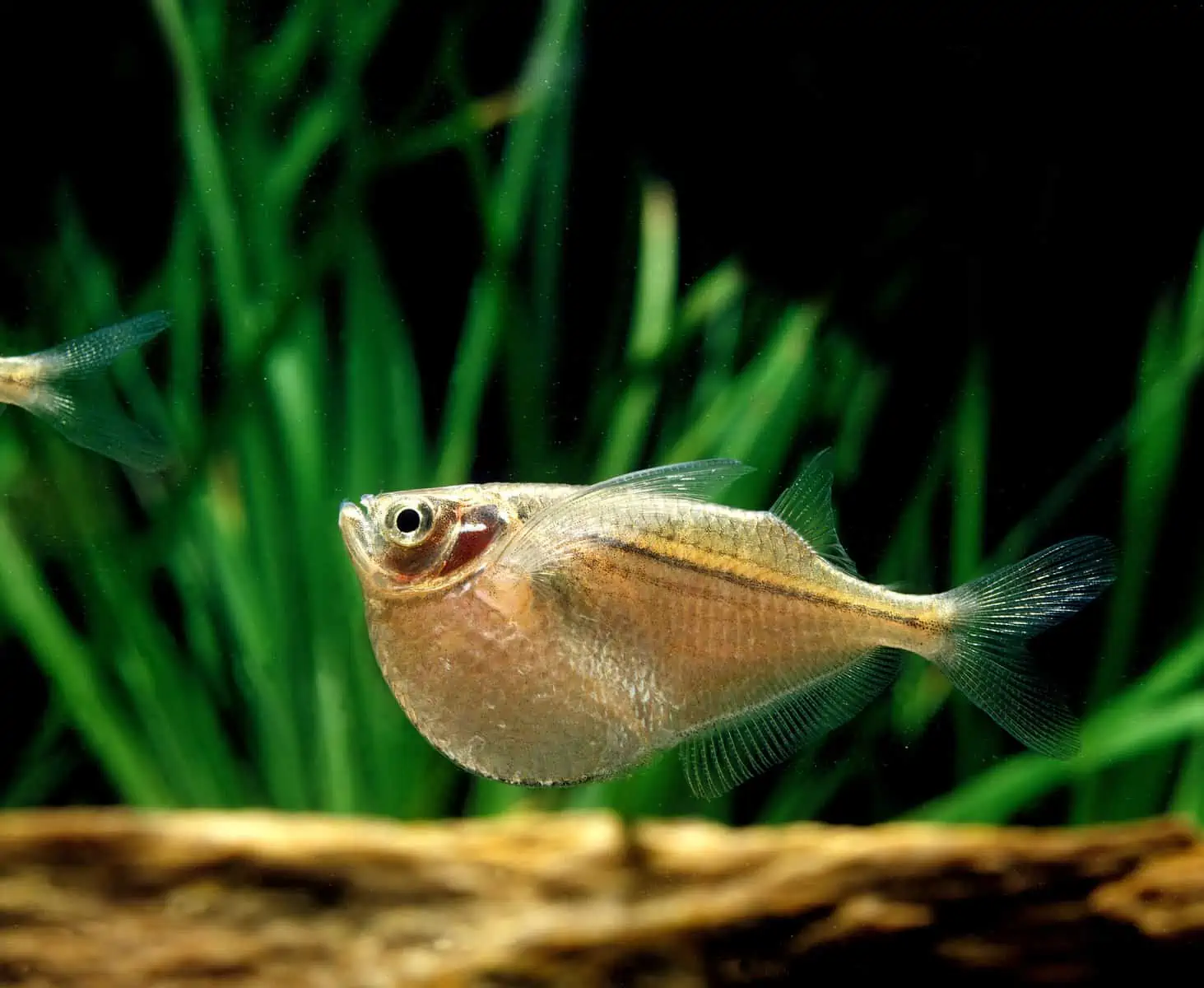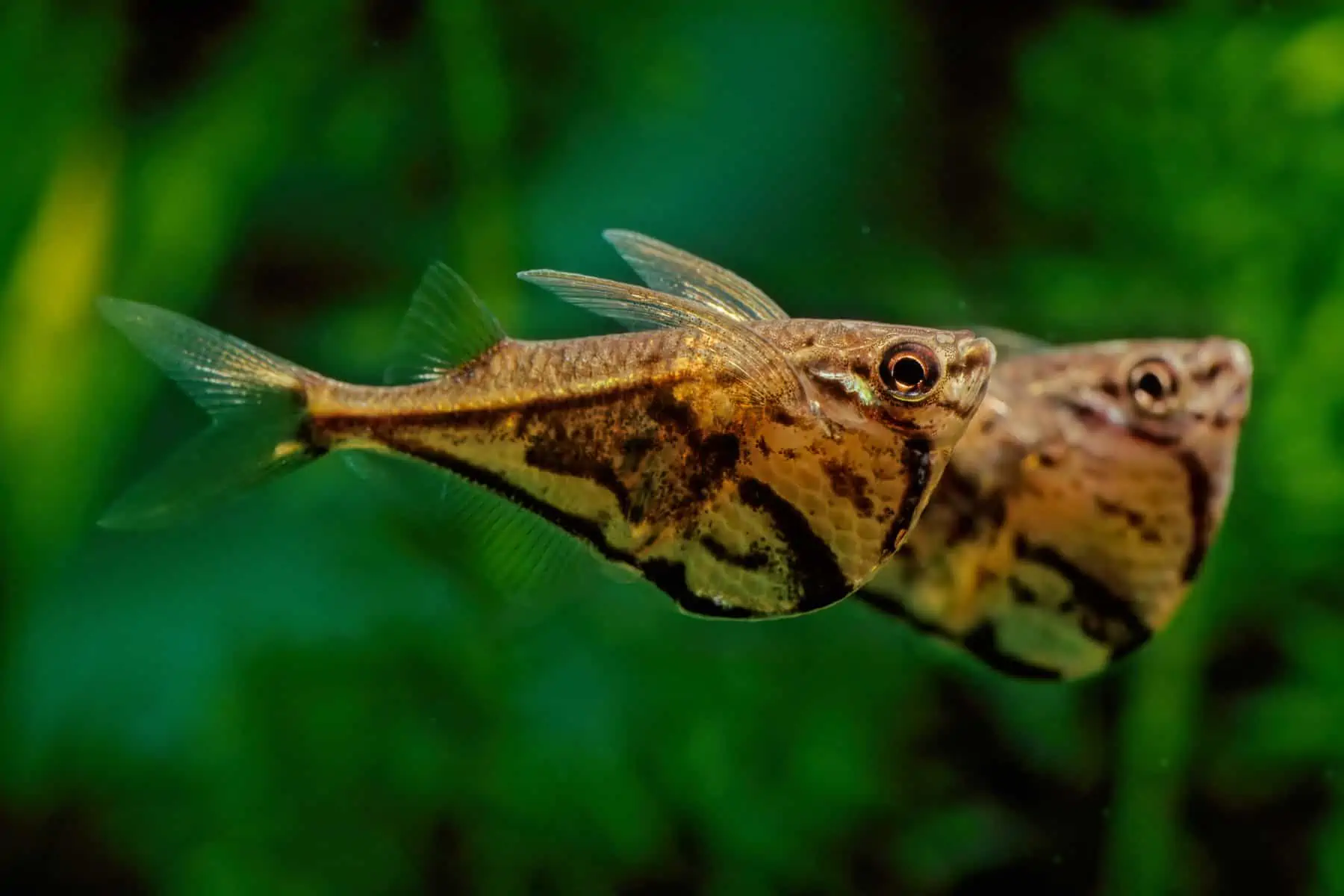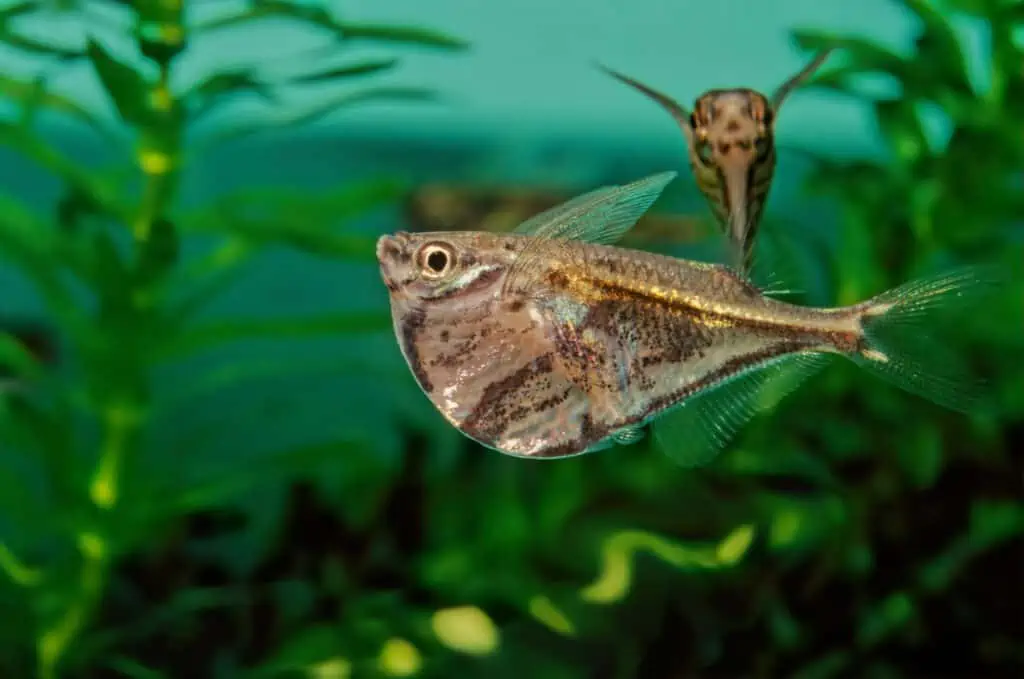Hatchetfish have long been a popular tropical fish in many home aquariums. These unique triangular-shaped fish are active, peaceful fish that can make an exciting addition to a community tank.
But did you know that the hatchetfish is a fast predator? These remarkable fish can ” fly” out of the water, using their wing-like fins to take to the air and capture their insect prey!
Keep reading to learn everything you need to know about choosing and caring for the four kinds of hatchetfish found in the hobby.
Hatchetfish Species Overview
| Hatchetfish Info | |
|---|---|
| Family | Gasteropelecidae |
| Care Level | Advanced |
| Temperament | Peaceful |
| Color Form | Depends on species |
| Lifespan | 2 to 5 years |
| Size | 1.5 inches |
| Diet | Carnivore |
| Minimum Tank Size | 15 gallons |
| Compatibility | Peaceful but predatory |
Hatchetfish Background and Origins
There are nine species of hatchetfish split across three genera.
These fish come from the swamps and rivers of South and Central America, where they are found in pools, headwaters, and tributaries. Hatchetfish spend much of their time close to the water surface, flying more than four feet as they hunt insects.
Four Species
There are four species of hatchetfish that are commonly seen in the hobby:
- Silver hatchetfish (Gasteropelecus levis)
- Common hatchetfish (Gasteropelecus sternicla)
- Marbled hatchetfish (Carnegiella strigata)
- Blackwing hatchetfish (Carnegiella marthae)
In this guide, we look at each variety of hatchetfish in more detail so that you can decide which would do best in your setup.
Silver Hatchetfish

Silver hatchetfish are found in Brazil in the streams and canals of the Amazon River basin. Silver hatchetfish are sometimes seen in floodplain lakes during the rainy season.
Of all the hatchetfish species, the Silver hatchetfish is the shyest. This species is often confused with the Common hatchetfish, although the Silver variety is slightly smaller.
Behavior
Silver hatchetfish are shy creatures that spend much of their time hiding amid the roots of floating aquatic plants. So, you need to replicate that environment in your aquarium for the fish to feel safe and secure.
Silver Hatchetfish Appearance
A full-grown Silver hatchetfish measures 2 and 2¼ inches in length and typically lives for around three years in captivity.
These beautiful fish have a metallic silver body with black and bronze stripes. Like all hatchetfish, the Silver hatchetfish has a compressed, hatchet-shaped body.
Female fish are generally rounder in shape since they carry eggs. Other than that, both sexes are pretty much identical in appearance.
Tank Conditions
Silver hatchetfish do best when added to an established, mature tank where the water parameters are stable.
Tank Size
Silver hatchetfish need to live in groups of at least six individuals. Ideally, the tank should be at least 20 gallons. A long tank with plenty of surface space for the fish to congregate is the best choice.
Although the fish can jump in the wild, that behavior is rarely seen in the captive environment. That said, a tightly fitting lid is recommended for all hatchetfish species.
Tank Decoration
Replicating the fish’s conditions in their wild habitat is the best way to encourage the Silver hatchetfish to thrive in captivity. These fish appreciate floating plants in their tank to provide shelter and protection at the water surface, where the fish spend most of their time.
Water Parameters
Silver hatchetfish need stable water conditions and are very sensitive to high ammonia levels. So, you need to keep up with partial water changes and tank maintenance tasks for these to do well.
The optimal water parameters for Silver hatchetfish are:
- water temperature of 74°F to 83°F (23.3-28.3°C)
- pH range between 5.8 and 6.9
- water hardness of 2 to 12 dKH
Tank Mates
Silver hatchetfish are peaceful fish that can live with other small, sociable fish in a community tank.
Since Silver hatchetfish spend most of their time at the water surface or in the upper area of the water column, midwater and bottom-dwelling fish are good tank mates.
Steer clear of large, aggressive, or highly active fish that could hassle the Silver hatchetfish and stress them. Stress often leads to disease outbreaks and can easily be avoided by providing your hatchetfish with suitable, compatible tank mates.
Good tank mates for Silver hatchetfish are:
- Corydoras catfish
- Tetras
- Danios
- Platys
You should always keep Silver hatchetfish in groups of at least six. Do not keep single fish, as they will not thrive.
Diet
Silver hatchetfish are carnivorous fish that need a protein-rich diet, including frozen, live, and freeze-dried meaty foods.
Bloodworms, blackworms, daphnia, brine shrimp, fruit flies, mosquito larvae, and tubifex are good foods for hatchetfish. However, flake foods are also accepted.
Health and Disease
Provided that you keep your tank clean and well-maintained and feed your fish a high-quality diet, your Silver hatchetfish should thrive.
However, Silver hatchetfish do not appreciate alkaline water conditions, making the fish more susceptible to diseases such as Ich. Stress is also a big contributor to health problems in hatchetfish. So, if you provide a peaceful environment for your fish, they will remain active and brightly colored.
Breeding Silver Hatchetfish
Silver hatchetfish deposit their eggs on the leaves of floating plants. However, there are no records of these beautiful fish being bred successfully in a home tank, and little is known about their spawning habits.
Common Hatchetfish

Common hatchetfish or River hatchetfish are often confused with Silver hatchetfish and are sometimes sold as such. However, Common hatchetfish are a completely different species.
Common hatchetfish are larger than their Silver counterparts and are less timid. Common hatchetfish are found in the central area of the Amazon River basin, to the west of Peru and the north in Venezuela, as well as in Suriname and Guyana.
Behavior
Common hatchetfish are just about the least active of the species. Rather than chasing their prey, the fish stalk it, using their excellent vision.
Appearance
Common hatchetfish grow to measure around 2.5 inches long, although they can sometimes grow slightly larger than that. The fish have a life expectancy of between three and five years.
The fish has a silver body with a prominent black stripe and an upturned mouth typical of most surface feeders. Common hatchetfish are sleeker and have a larger belly than Silver hatchetfish, and their flight-assisting pectoral fins are higher up on their body.
Tank Conditions and Size
Common hatchetfish should be kept in groups in a tank of at least 15 gallons.
Like Silver hatchetfish, Common hatchetfish can also fly, using their fins to propel them out of the water. However, the Common hatchetfish is known as a jumper in captivity, so your tank must have a cover slide or well-fitting lid.
Water Parameters
These fish prefer soft water since that closely replicates their natural water conditions. The fish’s preferred water parameters are:
- water temperature 72°F to 79°F (22.2-26.1°C)
- pH levels in the range of 6.0 to 6.8
- water hardness would be 2 to 14 kKH
Common hatchetfish need clean water and stable conditions, so you need a good filtration system, regular water changes of 25% to 50%, and water testing.
Decoration
The Common hatchetfish likes plenty of floating plants in their habitat where they can hide and stalk their prey. Like other hatchetfish, Common hatchetfish are fine under moderate lighting conditions, which also suit your surface plants.
Tank Mates
Unlike the Silver hatchetfish, the Common hatchetfish is not as timid, so they tend not to be as susceptible to stress. For that reason, Common hatchetfish usually do well in a peaceful community tank.
However, you should avoid including aggressive or semi-aggressive species that could hassle the hatchetfish or outcompete them for food.
Good tank mates for Common hatchetfish include:
You can keep Common hatchetfish in groups of eight or more.
Diet
Common hatchetfish are carnivores. These fish enjoy a diet of tiny insects and crustaceans, including vinegar flies and mosquito larvae.
In the captive environment, you can feed your hatchetfish a varied diet of fish flakes and live and frozen foods, including bloodworms, pinhead crickets, brine shrimp, and fruit flies.
Ideally, you should feed your hatchetfish a few times every day, ensuring that they don’t overeat, as that can cause digestive problems. We recommend you turn off your filter when feeding your fish so the food can’t sink before it gets a chance to eat it.
Health and Disease
Common hatchetfish are vulnerable to the same diseases as Silver hatchetfish. However, you can prevent health problems for your fish by providing them with a clean tank and checking the water parameters weekly.
These fish do best when introduced to a mature aquarium. Quarantine any new fish for at least two weeks before adding them to your tank to help keep parasites and diseases out.
Breeding
Although we know these fish are egg layers, there are no records of Common Hatchetfish breeding successfully in captivity.
Blackwing Hatchetfish
Blackwing hatchetfish are the smallest of the four hatchetfish species we’re featuring in our guide, growing to just 1.25 inches long.
These fish come from Colombia and Venezuela, where they inhabit still, heavily vegetated waters. Blackwing hatchetfish are not especially active, so they don’t need much open swimming space.
Behavior
Blackwing hatchetfish are the timidest of the four species we’re reviewing in this guide. So, if you take on some of these fish, you must provide them with plenty of hiding places and floating plants.
These shy creatures are easily frightened by boisterous tank mates and can even become upset by activity outside the tank.
Appearance
The Blackwing hatchetfish has black pectoral fins and a black back, hence the fish’s common name. The underside of the body is brilliant silver, shading a darker color toward the top of the body.
The fish’s body is the characteristic hatchet shape of all hatchetfish, with an upturned mouth typical of all surface feeders.
Tank Conditions
As mentioned earlier, these are shy fish that are less stressed with a lower lighting level and plenty of floating plants to shelter in. These hatchetfish look most impressive when displayed against a dark-colored substrate.
Tank Size
Since these hatchetfish are not especially active, a 15-gallon aquarium is adequate to accommodate them.
Although these hatchetfish are less likely to jump than other species, we recommend choosing a tank with a tightly fitting lid, just in case.
Water Parameters
Blackwing hatchetfish are sensitive to alkaline water conditions. The ideal water parameters for this species of hatchetfish are similar to those preferred by others in the family.
- water temperature 74°F to 83°F (23.3-28.3°C)
- water pH in the range of 5.8 to 6.9
- water hardness of 2 to 12 dKH
Tank Mates
The Blackwing hatchetfish is a peaceful fish that generally does well in a community setup.
That said, these fish need to be housed with other non-aggressive species of a similar size or smaller. Highly active, aggressive fish will stress the hatchetfish, leading to stress and possible health problems.
Suitable tank mates for Blackwing hatchetfish include:
- Corydoras catfish
- Shrimp
- Dwarf cichlids
- Tetras
- Snails
Blackwing hatchetfish should not be kept singly and do best when kept in groups of at least six.
Diet
Blackwing hatchetfish enjoy a varied, protein-rich diet that can include fish flakes and live and frozen foods.
Good foods for Blackwing hatchetfish include:
- bloodworms
- crickets
- brine shrimp
- daphnia
- tubifex
- fruit flies
If you decide to feed live foods, always ensure that the food comes from a reliable source to avoid accidentally introducing diseases and parasites into your tank.
Health and Disease
Blackwing hatchetfish can thrive and live out their full four-year lifespan, provided that they are given a varied, high-quality diet and kept in a well-maintained tank with optimal water conditions.
Breeding
To our knowledge, Blackwing hatchetfish have not been bred successfully in captivity.
Marbled Hatchetfish

The Marbled hatchetfish is the most popular hatchetfish in the hobby today. This species of hatchetfish is smaller than the Common hatchetfish, only reaching 1.75 inches in length.
The Marbled hatchetfish is also the shortest-lived, with a lifespan of around two years.
Behavior
Marbled hatchetfish are the most prolific and efficient jumpers of all hatchetfish. These tiny fish can jump over 5 feet high or forward, which is astounding considering that the fish are less than 2 inches long.
In fact, most of the fish’s body weight comes from their abnormally large pectoral fins, and it’s that physical adaptation makes the fish such incredible jumpers.
Appearance
The Marbled hatchetfish is a strikingly beautiful fish, having an iridescent body with bronze stripes and a black marbled body.
The fish have large eyes and the familiar upturned surface feeder’s mouth shared by the other hatchetfish species.
Tank Conditions
Marbled hatchetfish have slightly different requirements than the other hatchetfish varieties we’ve featured in this article.
Tank Size
Marbled hatchetfish are active fish that need plenty of space to swim and move around. So, we recommend starting with a 20-gallon aquarium.
As mentioned earlier, these fish are amazing jumpers, so you need a tank with a lid or a cover slide to avoid accidents.
These fish are surface feeders that spend much of their time in the upper regions of the water column. For that reason, a long, rectangular tank is the best choice.
Tank Decoration
Floating plants are essential in a hatchetfish aquarium, and tall, grassy plants that grow to the surface are also a good addition.
However, you must remember that Marbled hatchetfish are active swimmers that need plenty of space to swim around the tank.
Water Parameters
Like other hatchetfish, Marbled hatchetfish are highly sensitive to water conditions.
Hatchetfish need more acidic water, as they don’t do well in alkaline conditions. The ideal water conditions for Marbled hatchetfish are:
- water temperature 74°F to 80°F (23.3-26.7°C)
- pH levels in the range of 5.6 to 6.5
- water hardness 2 to 12 dKH
To keep the environment safe and healthy for your fish, carry out regular water tests to ensure that the parameters are within the acceptable range.
Tank Mates
Marbled hatchetfish are peaceful fish that generally do well in a community setup with other similar-sized, peaceable fish species that share the same water parameters.
We recommend that you don’t choose tank mates that tend to hang out at the top of the water column since Marbled hatchetfish don’t appreciate company in their feeding area.
Fish species to avoid include bettas, danios, and tiger barbs. We also don’t recommend keeping Marbled hatchetfish with other hatchetfish species.
Unfortunately, Marbled hatchetfish are quite territorial and can become aggressive toward their own kind. Therefore, most experienced aquarists generally keep only one specimen of these attractive fish.
Diet
Marbled hatchetfish are carnivores that need a high-protein diet containing plenty of meaty protein. You can feed your hatchetfish live, frozen, and freeze-dried foods supplemented with fish flakes.
Suitable foods for Marbled hatchetfish include:
- bloodworms
- tubifex
- protein flakes
- fruit flies
Marbled hatchetfish will appreciate the inclusion of live foods in their diet, but you must be sure that the source of the food is reliable, as you don’t want to risk introducing parasites to your aquarium.
Health and Disease
Unfortunately, Marbled hatchetfish have a significantly shorter lifespan than other hatchetfish. However, if cared for properly and fed a varied, high-quality diet, the fish can survive for their full life expectancy.
Marbled hatchetfish are vulnerable to common fish diseases, including Ich and bacterial infections. However, keeping the tank clean and well-maintained can protect your hatchetfish from these and other stress-related health conditions.
Breeding Marbled Hatchetfish
Unlike other hatchetfish species, the Marbled hatchetfish can be successfully bred in captivity.
To breed Marbled hatchetfish, you must set up a separate, dedicated spawning tank with mildly acidic, soft water. Following a long courtship, the female fish deposits her eggs across plants in the tank.
The male hatchetfish fertilizes the eggs, which usually hatch within a couple of days.
Once the eggs have been fertilized, we recommend removing the parent fish in case they eat the eggs and fry.
Final Thoughts
Did you enjoy our guide to the four most popular species of hatchetfish in the hobby? If you did, please take a moment to share the article.
Hatchetfish are beautiful fish that can make a good addition to a community tank that contains peaceful species of a similar size. With the exception of the territorial Marbled hatchetfish, most hatchetfish varieties are somewhat shy and must be kept in schools.
Do you keep hatchetfish? What species do you have, and what tank mates work best? Tell us in the comments box below.


